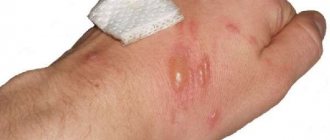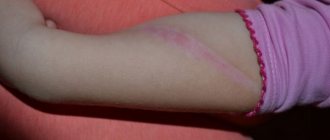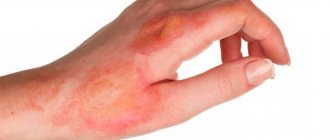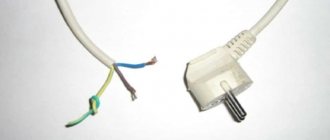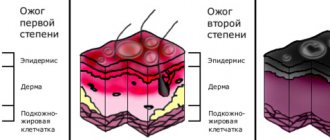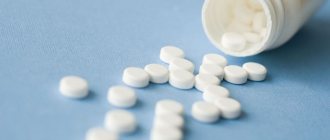At the burn site, the victim experiences pain of varying intensity.
A finger burn refers to an injury that occurs at home, at work or in everyday life. Damage to the skin can be superficial, or deeper layers are affected. At the burn site, the victim experiences pain of varying intensity. It is not always possible to eliminate injuries sustained at home on your own. Deep lesions require qualified treatment.
First aid for burns with hot water
Often, succumbing to panic, a person who has received a burn with hot water cannot properly provide first aid to himself or resorts to dubious folk remedies for a burn with hot water. Therefore, here is a list of actions that are PROHIBITED:
- Do not apply anti-inflammatory agents for burns with hot water to skin that has not been pre-cooled;
- Do not smear the wound with iodine, alcohol, brilliant green, vinegar and other irritating substances. Oils are also not suitable for these purposes (sea buckthorn oil is used only at the stage of subsequent treatment of a burn with hot water);
- It is strictly contraindicated to puncture blisters;
- Clothes stuck to the affected area are not torn off, but carefully cut off;
- Hot water burns are washed with water only. A solution with citric acid is appropriate for alkali damage, and an alkaline solution for acid burns, but in case of thermal damage it is strictly forbidden to use them;
- You should not lubricate the wound with fermented milk products, since the bacteria they contain, as well as various food additives, can cause an infection.
When to go to the doctor
If you have burns on your fingers, you should see a doctor in the following cases:
- there is a deep wound;
- a crust has formed due to protein coagulation - bacteria can begin to multiply under it;
- the person feels severe pain;
- when damaged by alkalis, they will continue to destroy tissue, so neutralization with sugar, acetic acid or glycerin is necessary.
You can quickly remove acid residues from the skin using a soda solution - 5 g per glass of water. In any case, the area is first washed with water and then treated with neutralizers.
In most cases, people do not know how to act with a particular substance depending on its chemical composition, so it is better to consult a doctor.
What to do if you are burned by hot water?
So, what should be the help for a hot water burn? A number of measures should be taken:
- first of all, it is necessary to stop the effect of hot liquid on the skin; remove clothes if possible;
- cool the wound. However, you should not immediately use ice or very cold liquid, especially when it comes to a hot water burn on a child. A sudden change in temperature may cause shock to the baby. Cool the burn site for 10-15 minutes;
- after the skin is cooled, an anti-inflammatory agent (Panthenol, Levomikol) is applied to it;
- For second-degree burns, when clothing cannot be completely removed, an antiseptic wet bandage is applied over the affected area. The face is not covered, but smeared with Vaseline;
- For particularly serious burns, it is advisable to administer an anesthetic. The victim needs to be wrapped and warmed with tea, and then given plenty of alkaline drink. In this case, calling a doctor is mandatory, since, for example, a serious burn to the head with hot water can be fatal.
Removal of scars after burns
Scars are dense connective tissue formations on the skin that appear after its regeneration. Scars are more likely to appear if operations have been performed in this area, as well as skin replacement with artificial implants.
To treat scars , corticosteroids, laser removal of keloids, cryodestruction, and surgical excision of scar tissue . In one procedure, no more than 3% of connective tissue can be eliminated, so as not to provoke the formation of a new scar.
Hot water burn: causes
At home, they resort to closed treatment, that is, one in which bandages with healing substances are applied to the burn site.
For a first-degree burn, it is enough to apply a bandage with an anti-inflammatory agent for 4-5 days. During this time, the skin will heal.
The first stage of treatment for a second-degree burn is carried out by a doctor, and further care is carried out by the patient himself or his relatives.
The doctor treats the burn surface. This procedure includes a number of steps:
- anesthesia;
- treating the skin around the wound with an antiseptic;
- removal of clothing, dirt and exfoliated layer of epithelium;
- emptying the blisters without removing their lid, which serves as wound protection;
- applying a gauze bandage with bactericidal ointment (streptomycin, levosulfamethakaine, etc.) to the burn site.
The dressing is changed every two to three days until the wound is completely healed.
Treatment at home
If you burn your fingers with boiling water, it is recommended to immediately immerse them in cold water. This will stop the negative thermal effects.
ethnoscience
Do not use any oily substances on a fresh burn. For superficial burns, a compress of calendula oil can be applied on the second or third day. The herb has a strong antiseptic and wound healing effect.
Soak the bandage with aloe juice.
When applying a bandage, you can pre-soak it with the juice of aloe, golden mustache or plantain. These plants include tannins and flavonoids, which accelerate tissue regeneration.
Ice is not used in healing therapy. Blood circulation in injured tissues is impaired, and exposure to extreme cold aggravates the situation. Also, pure iodine, which has a warming effect, is not suitable for processing.
Any bandage should not be tight so that a film is not created on the surface of the finger burn. If you follow the recommendations and there is no infection, recovery from a superficial burn occurs within a week.
Drug therapy
Panthenol normalizes cell turgor and restores their structure.
Special ointments will help speed up healing. But they can be applied no earlier than two hours after the injury. Most drugs contain panthenol, which normalizes cell turgor and restores their structure. For more severe burns, use Levomekol. It is also permissible to use pain-relieving ointments, for example, Ketonal. But if blisters appear, it is better to use oral analgesics.
Hot water burn: treatment
Patients with third or fourth degree burns are referred for inpatient treatment. In addition, in some cases (for example, a thermal internal burn of the foot with hot water), doctors resort to surgery, covering the burned area with skin and skin grafting.
Doctors have several priority tasks:
- promoting the rapid rejection of dead skin layers;
- formation of dry scab;
- prevention of purulent-inflammatory process;
- removal of toxic substances from the victim’s body.
In addition, hot water burns can cause burn disease in the patient. This complication occurs when a person is exposed to boiling water for a long time.
Types of burns
If you burn a finger on your hand, first aid is required. But initially they determine what type of injury was received.
- Thermal. The victim burns his finger with fire, steam, boiling water or a heating element. One of the deepest lesions is considered to be damage to the skin by hot objects. After its exposure, clear boundaries remain on the skin. Exposure time, temperature and thermal conductivity play a big role.
- Chemical. Skin damage on the fingers occurs after contact with aggressive acids and alkalis. Their degree is critical if the substance has a high concentration. If the epidermis is damaged, a strong scar subsequently remains.
- Radial. Occurs when exposed to ultraviolet, infrared rays and other types of radiation. Such injuries are often recorded at work, where appropriate equipment is used.
Finger burns are classified by degree
Degree of injury.
- the superficial lesion is accompanied by redness, stinging pain and slight swelling.
- Painful blisters or blisters containing lymph appear on the skin.
- a painful necrotic process of tissue begins with the formation of a scab.
- complete death of soft tissues affecting bone and muscle tissue.
Stages of a burn
This injury has four stages of development:
How to treat a burn with hot water?
I. Burn shock. It can last three days. In this case, the acid-base and water-electrolyte balance of the body is disrupted, and kidney function is disrupted.
II. Acute burn toxemia. Lasts about two weeks. During this time, blood circulation and kidney function are normalized, due to which the absorption of toxins from the affected area begins. If kidney function does not recover (in extremely severe burns), renal failure develops.
III. Septicotoxemia. This stage occurs only with severe burns and accompanies the beginning of wound cleansing. As a result of blockage of blood vessels during circulatory dysfunction, damage to various organs (gastrointestinal tract, lungs, etc.) occurs.
IV. Convalescence. The final stage, which continues until complete recovery.
Classification of burns
Based on the depth of tissue damage, doctors distinguish four degrees of burns.
The first one is easy. The top layer of skin is damaged. The epithelium turns red and swells. The wound is accompanied by a strong burning sensation. Heals in 3-4 days even without treatment.
The second is of medium severity. The epithelium and dermis suffer. At the same time, blood vessels and nerve fibers remain in order. The person experiences acute pain and burning. Small blisters appear at the site of damage. They are filled with clear liquid. Heals within 2 weeks.
The third one is hard. The skin is damaged to its full depth. Blood vessels. Partially subcutaneous tissue. Large blisters form. Some of them burst. Pain sensitivity in the injured area decreases.
The fourth is extremely difficult. Skin, muscles, tendons, and bones are severely damaged. Necrosis of the injured area occurs.
The first two degrees cause burning and pain. The third and fourth are accompanied by pain only at the time of injury. Then pain sensitivity decreases. The reason is the destruction of nerve fibers.
Experts' opinion
The conducted clinical study proves the high efficiency, safety and tolerability of products for daily care of children's skin. As a result of therapy, a decrease in the activity of the inflammatory process, a decrease in dryness, itching and flaking was noted. The products will also be effective in the treatment of minor burns.
Sources:
- Schneiderman Paul, Grossman Mark, Differential diagnosis in dermatology. Atlas, Publishing house: Binom, 2017
- Reken Martin, Schaller Martin, Sattler Elke, Burgdorf Walter, Atlas of Dermatology, MEDpress-inform publishing house, 2018
- Yagodka Valentina Stepanovna, Medicinal plants in dermatology and cosmetology, Naukova Dumka publishing house, 1991
Symptoms and severity
There are four types of damage received:
- The first is that the upper outer layers of the skin are damaged. Redness forms on the fingers, accompanied by minor pain.
- Second, the burned area becomes covered with a blister, and acute pain is felt.
- The third is caused by damage to the deep layers of the skin. After recovery, scars and scars may remain.
- The fourth is the most dangerous type. All tissues of the finger are affected, affecting ligaments and bones, even to the point of charring. Recovery in this case is problematic; there is a high risk of amputation of the phalanx.
Treatment
If you receive a severe burn, you should immediately seek help from a dermatologist. A qualified doctor knows what to do in case of finger burns and how to treat the resulting injuries. The victim is prescribed powerful antibacterial and painkillers. The affected area is treated with special ointments and a loose bandage is applied. The patient is registered and visits the hospital for dressings and further rehabilitation.
It is allowed to treat mild lesions on your own, the main thing is to follow the dosage of medications and ointments for the burn. With proper treatment, no complications are observed; the burned finger recovers after a few days (7-10).
